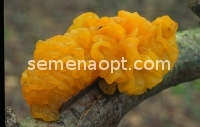
-
- Notice
- No new notifications
-
- Messages
- See all notifications
-
18
- The cart
In the basket 0
in the amount of 0 RUB
- Go to basket
Vegetable seeds Flower seeds Grapes (plants) Mushrooms Agrochemicals
|

|
|
Fruit body: the size of 2 - 5 cm,paddle or faceted, irregular, and the bright yellow-orange yellow Flesh: soft, gelatinous, yellow . Grows: from mid-August to late October on dry branches and stumps of deciduous trees (on the bank), single and group, often annually Tremella mesenterica (Common names include brain yellow, golden jelly fungus, yellowtrembler, oil and witch) is a common fungus jelly in a family of Tremellaceae Agaricomycotina . This is most often found on the dead, but investments and recently fallen branches, especially angiosperms, the parasite fungi rotting wood in the genus Peniophora . gelatin, orange-yellow fruiting body of the fungus, which can grow up to 7.5 cm (3.0inch) diameter, has an intricate or blade surface, greasy or slimy when wet . It grows in the cracks of the bark, resulting in rainy weather . For a few days after the rain it dries into a thin film or shriveled mass can revive after subsequent rain . This fungus commonly found indeciduous and mixed forests and is widely distributed in temperate and tropical regions, which include Africa, Asia, Australia, Europe, North and South America . Although it is considered a soft and tasteless, edible fungus . Tremella mesenterica produces carbohydrates that attract research interest due to their different biological activity. Basidia (sporogenous cells) ellipsoid approximately spherical shape, or rarely pursued, and typically 15 - 21 microns in width . They contain 3:58 partitions that divide it into compartments, baffles are often vertical, or diagonal . asexual reproduction in T . mesenterica through the formation of spores called conidia,which arise from the conidiophores specialized hyphae cells that morphologically distinct from somatic hyphae . densely branched conidiophores and usually abundant in the shroud, juveniles can be completely conidial . Conidia almost spherical, ovoid, or elliptical, and about 2.0 - 3.0 2.0 - 2.5 um . They may be somany young fruiting bodies can be covered in a bright yellow, conidial slime . Spores broadly ellipsoid to oblong, an average of 6 . 0 - 9 . May 10 . 0 - 16 . 0 microns . They germinate sex probe or yeast-like conidia identical forms conidia produced on conidiophores
| SPECIFICATIONS | |
|---|---|
| Bag | |
| Form dispute | from to oblong ellipsoid |
| The size of the dispute | 6 . 0 - 9 . 5 10 . 0 - 16 . 0 mm |
| Description | |
| Name in latin | Tremella mesenterica |
| Rod | tremella |
| Fruiting bodies are formed (grows) | mid-August to late October |
| Class | Tremellomycetes |
| Edible | edible mushroom |
| Distribution | commonlyfound in deciduous and mixed forests and is widely distributed in temperate and tropical regions, which include Africa, Asia, Australia, Europe, North and South America , |
| Taste | soft |
| Grow | on dry branches and stumps of deciduous trees (on birch), single and the group, often annually |
| Smell | with a delicate aroma |
| Fruiting body (Cap) | |
| Surface | greasy or slimy when wet |
| Color | bright yellow and yellow-orange color |
| Height | 2 - 5 cm |
| Diameter | can grow up to 7.5 cm (3.0 inches) |
| Form | paddle or faceted, irregular shape |
| Features | conidia almost spherical, ovoid or elliptical, and about 2.0 - 3.0 to2.0 - 2.5 um |
| Plant | |
| Basidia | approximately ellipsoidal spherical shape typically 15 - 21 microns wide |
| Flesh | dry, brittle |
| Features | growing in bark cracks occurring in rainy weather . For a few days after the rain it dries into a thin film |
Enter your information
To recover the password
Forgot password? Enter your e-mail
Registration for new users
Enter your details: